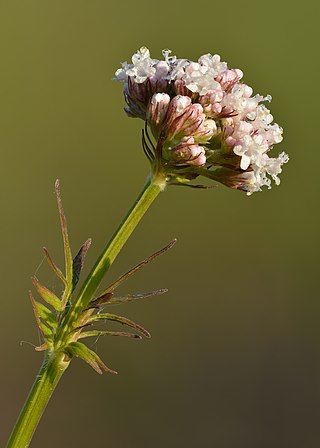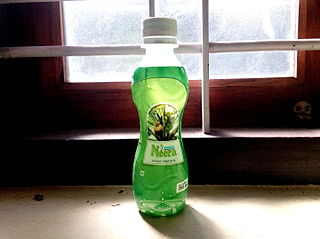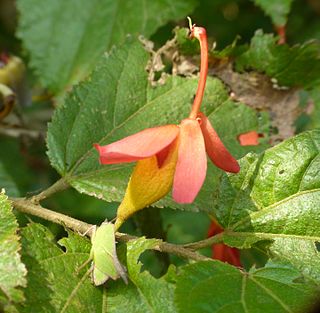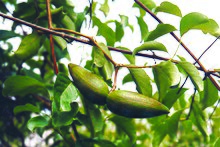
Valerian is a perennial flowering plant native to Europe and Asia. In the summer when the mature plant may have a height of 1.5 metres, it bears sweetly scented pink or white flowers that attract many fly species, especially hoverflies of the genus Eristalis. It is consumed as food by the larvae of some Lepidoptera species, including the grey pug.

Azadirachta indica, commonly known as neem, margosa, nimtree or Indian lilac, is a tree in the mahogany family Meliaceae. It is one of two species in the genus Azadirachta. It is native to the Indian subcontinent and to parts of Southeast Asia, but is naturalized and grown around the world in tropical and subtropical areas. Its fruits and seeds are the source of neem oil. Nim (नीम) is a Hindustani noun derived from Sanskrit nimba (निंब).

Kava or kava kava is a crop of the Pacific Islands. The name kava is from Tongan and Marquesan, meaning 'bitter'; other names for kava include ʻawa (Hawaiʻi), ʻava (Samoa), yaqona or yagona (Fiji), sakau (Pohnpei), seka (Kosrae), and malok or malogu. Kava is consumed for its sedating effects throughout the Pacific Ocean cultures of Polynesia, including Hawaii and Vanuatu, Melanesia, some parts of Micronesia, such as Pohnpei and Kosrae, and the Philippines.

Polyphenols are a large family of naturally occurring phenols. They are abundant in plants and structurally diverse. Polyphenols include flavonoids, tannic acid, and ellagitannin, some of which have been used historically as dyes and for tanning garments.

Smilax ornata is a perennial trailing vine with prickly stems that is native to Mexico and Central America. Common names include sarsaparilla, Honduran sarsaparilla, and Jamaican sarsaparilla.

Hen and chicks is a common name for a group of small succulent plants. They belong to the flowering plant family Crassulaceae, native to southern Europe and northern Africa. The plants grow close to the ground with leaves formed around each other in a rosette, and propagating by offsets. The "hen" is the main, or mother, plant, and the "chicks" are a flock of offspring, which start as tiny buds on the main plant and soon sprout their own roots, taking up residence close to the mother plant.

Garcinia gummi-gutta is a tropical species of Garcinia native to South Asia and Southeast Asia. Common names include Garcinia cambogia, as well as brindle berry, and Malabar tamarind. The fruit looks like a small pumpkin and is green to pale yellow in color.

Eurycoma longifolia is a flowering plant in the family Simaroubaceae. It is native to Indochina and Indonesia, but has also been found in the Philippines. The plant is a medium-sized slender shrub that can reach 10 m (33 ft) in height, and is often unbranched. The root of the plant has been used in folk medicine of the South East Asian region, and in modern times has common use as supplements, as well as food and drink additives.

Moringa oleifera is a fast-growing, drought-resistant tree of the family Moringaceae, native to the Indian subcontinent and used extensively in South and Southeast Asia. Common names include moringa, drumstick tree, horseradish tree, or malunggay.

Hemidesmus indicus, Indian sarsaparilla, is a species of plant found in South Asia. It occurs over the greater part of India, from the upper Gangetic plain eastwards to Assam and in some places in central, western and South India.

Rubia cordifolia, known as Indian madder, is a species of flowering plant in the coffee family, Rubiaceae. It has been cultivated for a red pigment derived from roots.

Neera, also called palm nectar, is a sap extracted from the inflorescence of various species of toddy palms and used as a drink. Neera extraction is generally performed before sunrise. It is sweet, translucent in colour. It is susceptible to natural fermentation at ambient temperature within a few hours of extraction, and is also known as palm wine. Once fermented, Neera becomes toddy. Neera is widely consumed in India, Sri Lanka, Africa, Malaysia, Indonesia, Thailand, and Myanmar. Neera is not the juice made from palm fruit.

Melilotus indicus, sometimes incorrectly written Melilotus indica, is a yellow-flowered herb native to northern Africa, Europe and Asia, but naturalized throughout the rest of the world.

Rubus coreanus, known as bokbunja, Korean blackberry, or Korean bramble, is a species of raspberry native to Korea, Japan, and China. It produces edible berries that can be fermented into bokbunja ju, a Korean fruit wine. R. coreanus fruits are usually harvested between the May and July at peak harvest season. They can only be cultivated in a few areas in Korea, different to Rubus occidentalis, which can be cultivated widely across the country.

Quercus infectoria or the Aleppo oak is a species of oak well known for producing galls that have been traditionally used for centuries in Asia medicinally while also used in softening leather and in making black dye and ink.

Ichnocarpus frutescens is a species of flowering plant in the dogbane family Apocynaceae, known by the English common name black creeper. It is native to much of China, India, Southeast Asia, and northern Australia.

Helicteres isora, sometimes called the Indian screw tree, is a small tree or large shrub found in southern Asia and northern Oceania. It is usually assigned to the family Malvaceae, but it is sometimes assigned to the family Sterculiaceae. The red flowers are pollinated mainly by sunbirds, butterflies, and Hymenoptera. In the 19th century fibers from the bark were used to make rope and sacks, although nowadays the tree is harvested for the fruits and roots which are used in folk medicine.

Decalepis arayalpathra is a species of plant in the family Apocynaceae. It is endemic to Peninsular India and known by its names of amirtha palaM in Tamil is a plant whose root is used in Ayurvedic medicines.



















